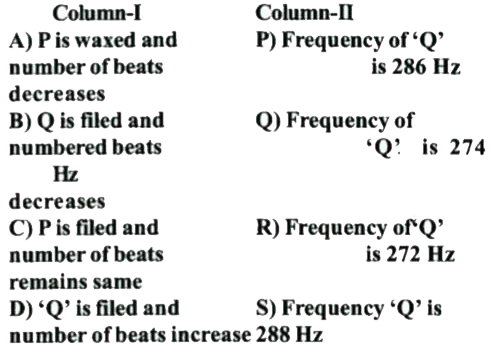Turning fork A of frequency 305 Hz produces 5 beats s−1 with another turing fork B. After filling tuning fork B, it produces 3 beats s−1 with A. The frequency of B before filling was
300 Hz
313 Hz
310 Hz
308 Hz
The correct Answer is:A
The phenomenon of beats is used in the determination of unknown frequencies.
Suppose v2 is the unknown frequency of a tuning fork B. Let this fork B produce m beats per second with another tuning fork A of known frequency v1, As number of beats/s is equal to difference in frequency of two sources.
Therefore, v2=v1±m
When the prong of fork B is filed a little, it becomes lighter and its frequency of vibration increases on sounding the filed fork B with fork A, we count the number of beats s−1. Proceeding as, we conclude that, if number of beats s−1 on filing fork B of unknown frequency increases, m would So, frequency of tuning fork B
=305±5=310Hz,300Hz
Since, on filing tuning fork B, number of beats decreases. This means that frequency of B should be less ie, 300 Hz
Topper's Solved these Questions
- WAVE MOTIONBook:MHTCET PREVIOUS YEAR PAPERS AND PRACTICE PAPERSChapter:WAVE MOTIONExercise:Exercise 2
Explore 30 Videos
- SURFACE TENSION Book:MHTCET PREVIOUS YEAR PAPERS AND PRACTICE PAPERSChapter:SURFACE TENSION Exercise:MHT CET Corner
Explore 15 Videos
- WAVE THEORY OF LIGHT Book:MHTCET PREVIOUS YEAR PAPERS AND PRACTICE PAPERSChapter:WAVE THEORY OF LIGHT Exercise:MHT CET CORNER
Explore 4 Videos
Similar Questions
A tuning fork A produces 5 beats/sec with another tuning fork B of frequency 256 Hz. If tuning fork A produces 1 beats/sec with some other tuning fork C of frequency 250 Hz, then calculate the frequency of fork A.
View SolutionA tuning fork arrangement (pair) produces 4beats/sec with one fork of frequency 288cps. A little wax is placed on the unknown fork and it then produces 2beats/sec. The frequency of the unknown fork is
View Solution
Knowledge Check
Tuning fork A of frequency 205 Hz produces 5 beats/sec with another fork B. After filing the tuning fork B, it produces 3 beats/sec with A. What was the frequency of the fork B before filling?
A310 HzB313 HzC308 HzD300 HzA tuning fork 'P' of frequency 280Hz produces 6 beats/s with unknown tuning fork 'Q'
 AABCDQRSRBABCDQRQPCABCDP.QQ.RR.SPDABCDR.SQ.RSR
AABCDQRSRBABCDQRQPCABCDP.QQ.RR.SPDABCDR.SQ.RSRA tuning fork A produces 4 beats/sec with another tuning fork B of frequency 320 Hz . On filing the fork A , 4 beats/sec are again heard. The frequency of fork A , after filing is
A324 HzB320 HzC316 HzD314 Hz
A tuning fork when sounded along with a standard source of frequency 300 Hz produces 5 beats s−1. The tuning fork when loaded by some wax is again found to give 5 beat s−1 with the standard source. The original frequency of the fork is
View SolutionTuning fork F1 has a frequency of 256 Hz and it is observed to produce 6beats/second with another tuning fork F2. When F2 is loaded with wax, it still produces 6beats/sec with F1. The frequency of F2 before loading was
View SolutionA tuning foork A of frequenct 260 c/s Hz produces 4 beats per second when sounded with a tuning fork B. the number of beats produced per second becomes 3. Then, what is the frequency of tuning fork B?
View SolutionA tuning fork A produces 4 beats s−1 with another tuning fork B of frequency 320Hz. ON filing one of the prongs of A, 4 beats s−1 are again heard when sounded with the same fork B. Then the frequency of the fork a before filling is
View SolutionFrequency of tuning fork A is 256 Hz. It produces 4 beats/second with tuning fork B. When wax is applied at tuning fork B then 6 beats/second are heard. Frequency of B is :-
View Solution

